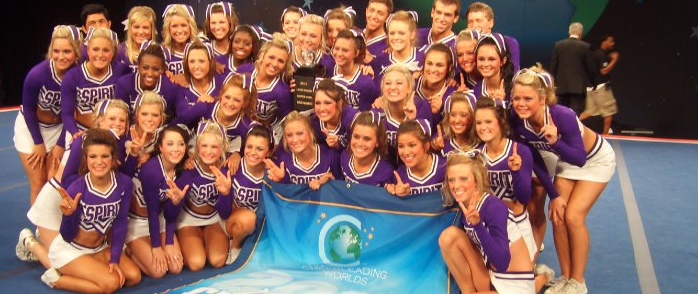Spotlight: Spirit of Texas
 2014 was a big one for Spirit of Texas—at the Summit, the gym placed third in Youth 3 and first in Senior 3. In addition, they snagged three silver medals at Worlds, and their coach Krista Godbee was appointed Coach of the Year by USASF. As this season shapes up to follow suit, Spirit of Texas looks poised to continue as one of the cheer world’s powerhouse organizations.
2014 was a big one for Spirit of Texas—at the Summit, the gym placed third in Youth 3 and first in Senior 3. In addition, they snagged three silver medals at Worlds, and their coach Krista Godbee was appointed Coach of the Year by USASF. As this season shapes up to follow suit, Spirit of Texas looks poised to continue as one of the cheer world’s powerhouse organizations.
Now celebrating its 20th season, the Dallas-based program was founded by Brett Allen Hansen and Brad Vaughan. Prior to joining forces, Hansen worked with Southwest Spirit, while Vaughan spent his days building choreography routines for Rebel Cheer Company. Realizing they both possessed a desire to run their own program, the duo teamed up to open their first location in Arlington, Texas in 1995.
According to Hansen, the partnership wasn’t instant. “We actually competed against each other for a couple of years before Brett and I merged,” he jokes.
But the result of the merger was a successful fusion of the co-owners’ varied skillsets. “Brad is very creative and he’s a really good choreographer,” says Hansen. “He also tackles things like the monthly newsletters and he’s the one that keeps the organizational side of the business running.” Hansen spends his days directing staff, prepping curriculum and coaching at the facilities.
The partnership has proven fruitful, with Spirit of Texas earning a reputation for polished routines and pristine choreography. Their secret? Old-school values. “We still embrace the things that were popular when we cheered: strong jump techniques, motion techniques, the fundamentals of cheerleading,” says Hansen. “I think that is probably something that people [associate with] our program—keeping everything clean and not sacrificing form for a new skill or trying to do something that’s not perfected.”
 As leaders, Hansen and Vaughan encourage their athletes to focus less on winning and more on development. “I tell them all the time, ‘I don’t care if you win, but what I care about is you doing a perfect routine,’” says Hansen. “If my teams go out and do a perfect routine, they are going to win. We don’t talk about winning. We just want them to go out there and hit a beautifully well-executed routine.”
As leaders, Hansen and Vaughan encourage their athletes to focus less on winning and more on development. “I tell them all the time, ‘I don’t care if you win, but what I care about is you doing a perfect routine,’” says Hansen. “If my teams go out and do a perfect routine, they are going to win. We don’t talk about winning. We just want them to go out there and hit a beautifully well-executed routine.”
Over the years, Spirit of Texas has continued to expand, opening a new location in Coppell, Texas in 2011. The additional practice space has made room for the organization’s increasing enrollment. “Just in all-star teams themselves, we’ve increased our enrollment by 25 percent each year since 2011,” Hansen explains, adding that the number of teams has increased from 12 to 15 since last season.
Hansen attributes much of the program’s growth to with the boom in the Dallas-Fort Worth market, which he says is “now the fourth largest metro area in the United States.” While it made sense to add the location further north to accommodate the growing demand, he’s also acutely aware that Texas is one of the most cutthroat markets in competitive cheerleading. However, Hansen doesn’t allow that to psyche himself out: “It takes so much time to focus on what your competitors are doing, and you need all that energy to develop your own athletes—it’s better not to even worry about it.”
Hansen relies on his gym’s reputation to attract athletes. “It’s positive, it’s fun, and the kids do well at competitions. Everybody hopes to be on a winning team.” As such, the owners strive to keep things fun. Adds Hansen, “Cheerleading has gotten so hard; we’re all such perfectionists and want to do well at competitions and sometimes practices aren’t fun. It needs to stay positive so the kids are still interested.”
In addition to top-notch athletes, the gym has been recognized for their effective coaching staff. The organization recruits coaches with strong cheer backgrounds, often from within. “Typically we hire from the inside out. Our own athletes become our own coaches when they age out, or they go to college and come back and want to teach,” explains Hansen.
As the program expands, the biggest challenge that Spirit of Texas is facing is inadequate floor space. And as the teams continue to multiply, the owners are looking to remedy that situation. “We are going to have to find a bigger facility or build one. That is definitely in the future,” says Hansen.
–Nicole Pajer








